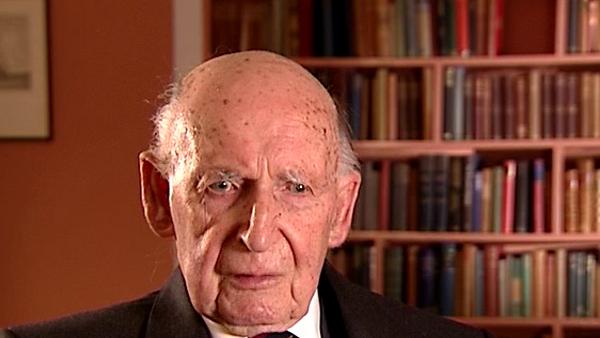NEXT STORY

Patrick Blackett takes over from Lawrence Bragg at Manchester
RELATED STORIES

NEXT STORY

Patrick Blackett takes over from Lawrence Bragg at Manchester
RELATED STORIES


|
Views | Duration | |
|---|---|---|---|
| 1. Early life in Oldland Common | 2 | 875 | 03:42 |
| 2. Secondary school and the lecture that changed my life | 1 | 630 | 04:54 |
| 3. Cricket and doing research on the conductivity of thin films of... | 267 | 07:02 | |
| 4. 'I'd really rather work with Blackett' | 235 | 06:37 | |
| 5. How I came to work with Douglas Hartree | 220 | 04:12 | |
| 6. Patrick Blackett takes over from Lawrence Bragg at Manchester | 203 | 04:22 | |
| 7. Patrick Blackett and work with cloud chambers | 221 | 02:51 | |
| 8. Clearing the cloud chambers | 163 | 01:59 | |
| 9. Werner Heisenberg and the theory of high energy particles | 1 | 430 | 03:03 |
| 10. Work on cosmic ray showers and an influx of refugees from Europe | 181 | 03:51 |

Bragg was then working in the Schuster Laboratory and the laboratory was packed with his staff, nearly all of whom were engaged in crystallography. Well, of course, this was wonderful work, which Bragg was one of the great experts, but I simply could not interest myself in crystallography. There was so much of it, and I realised later on that this was typical of me. I never... I was not then and never did really become interested in beginning research on subjects which had always been well explored. I always seemed to have this initiative and inkling to start new things. So I tried very hard to interest myself in crystallography. There's so much of it. Massive books and so many experts, that I thought it was not for me.
Two things then happened. I made the great mistake of trying to continue my work on thin films, but it was hopeless. I was given a room in the new physics building. Oh goodness, what that room was. In the basement, looking out on a brick wall and I thought of the lovely room I had worked in in Bristol, and I asked Burrough if he would make me another equipment so that I could continue my work. It was a very bad mistake. There were no facilities in Manchester, no glass blowing, no liquid oxygen or liquid nitrogen, and Burrough did send me the apparatus, but it got smashed in transport. So on that Christmas vacation, I did return to Bristol and complete another item of work on thin films, but meanwhile... and I can't remember how this happened.
Douglas Hartree, the professor of applied mathematics had become friends of the family of the girl with whom I'd fallen in love and whom I was to marry. Joyce Chesterman, well-known family in Bath. And I remember they would pick me up on their way back from the south country and it was Hartree who had built this amazing machine, the first differential analyser. The first integrated machine. A superb mechanical device and he asked me if I'd like to spend some time working with him on that machine, and I was delighted to do so. It was in the basement of the Schuster building, and though Hartree was the professor of applied mathematics, he did spend most of his time in the physics department, and there I met Dr. Arthur Porter, who became a life long friend and he was the person who built the original Meccano model of this differential analyser. I worked on that and helped Porter and Hartree solve a number of equations using this machine. I don't think I ever published any of the results for any of my work on that, but in later years as the modern computers took over, I'm very happy to have had association with that elementary machine.
Bernard Lovell (1913-2012), British radio astronomer and founder of the Jodrell Bank Observatory, received an OBE in 1946 for his work on radar, and was knighted in 1961 for his contribution to the development of radio astronomy. He obtained a PhD in 1936 at the University of Bristol. His steerable radio telescope, which tracked Sputnik across the sky, is now named the Lovell telescope.
Title: How I came to work with Douglas Hartree
Listeners: Megan Argo Alastair Gunn
Megan Argo is an astronomer at the University of Manchester's Jodrell Bank Observatory researching supernovae and star formation in nearby starburst galaxies. As well as research, she is involved with events in the Observatory's Visitor Centre explaining both astronomy and the history of the Observatory to the public.
Alastair Gunn is an astrophysicist at Jodrell Bank Observatory, University of Manchester. He is responsible for the coordination and execution of international radio astronomical observations at the institute and his professional research concerns the extended atmospheres of highly active binary stars. Alastair has a deep interest and knowledge of the history of radio astronomy in general and of Jodrell Bank in particular. He has written extensively about Jodrell Bank's history.
Tags: Schuster Laboratory, Bristol, Manchester, Christmas, Bath, Meccano, Lawrence Bragg, Douglas Hartree, Joyce Chesterman, Arthur Porter
Duration: 4 minutes, 12 seconds
Date story recorded: January 2007
Date story went live: 05 September 2008